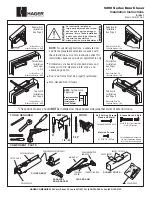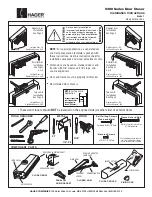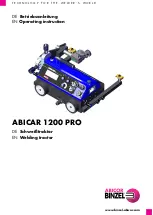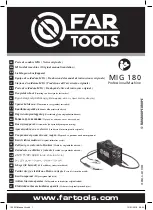
SMAW (STICK) WELDING
The welding current and Arc Force settings can be set through a
Power Feed
™
10M or Power Feed
™
25M wire feeder.
Alternatively an optional Stick / TIG UI can be installed into the
power source to control these settings locally.
In a
SMAW
(STICK mode), Arc Force can be adjusted. It can be
set to the lower range for a soft and less penetrating arc charac-
teristic (negative numeric values) or to the higher range (positive
numeric values) for a crisp and more penetrating arc. Normally,
when welding with cellulosic types of electrodes (E6010, E7010,
E6011), a higher energy arc is required to maintain arc stability.
This is usually indicated when the electrode sticks to the work-
piece or when the arc becomes unstable during manipulative
technique. For low hydrogen types of electrodes (E7018, E8018,
E9018, etc.) a softer arc is usually desirable and the lower end of
the Arc Control suits these types of electrodes. In either case the
arc control is available to increase or decrease the energy level
delivered to the arc.
GTAW (TIG) WELDING
The welding current can be set through a Power Feed 10M or
Power Feed
™
25M wire feeder. Alternatively an optional Stick /
TIG UI can be installed into the power source to control these
settings locally.
The
TIG
mode features continuous control from 5 to 350 amps
with the use of an optional foot amptrol. The Power Wave
®
S350
can be run in either a Touch Start TIG mode or Scratch start TIG
mode.
CONSTANT VOLTAGE WELDING
Synergic CV
For each wire feed speed, a corresponding voltage is
preprogrammed into the machine through special software at the
factory.
The nominal preprogrammed voltage is the best average voltage
for a given wire feed speed, but may be adjusted to preference.
When the wire feed speed changes, the Power Wave
®
S350
automatically adjusts the voltage level correspondingly to
maintain similar arc characteristics throughout the WFS range.
Non Synergic CV
In non-synergic modes, the WFS control behaves more like a
conventional CV power source where WFS and voltage are
independent adjustments. Therefore to maintain the arc
characteristics, the operator must adjust the voltage to
compensate for any changes made to the WFS.
All CV Modes
Pinch adjusts the apparent inductance of the wave shape. The
“pinch” function is inversely proportional to inductance.
Therefore, increasing Pinch Control greater than 0.0 results in a
crisper arc (more spatter) while decreasing the Pinch Control to
less than 0.0 provides a softer arc (less spatter).
PULSE WELDING
Pulse welding procedures are set by controlling an overall “arc
length” variable. When pulse welding, the arc voltage is highly
dependent upon the waveform. The peak current, back ground
current, rise time, fall time and pulse frequency all affect the
voltage. The exact voltage for a given wire feed speed can only
be predicted when all the pulsing waveform parameters are
known. Using a preset voltage becomes impractical and instead
the arc length is set by adjusting “trim”.
Trim adjusts the arc length and ranges from 0.50 to 1.50 with a
nominal value of 1.00. Trim values greater than 1.00 increase
the arc length, while values less than 1.00 decrease the arc
length. (See Figure B.3)
B-6
OPERATION
POWER WAVE
®
S350 & S350 ALUMINUM
FIGURE B.3
















































